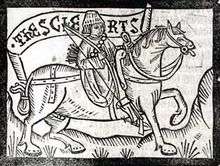The Clerk's Tale

The Clerk's Tale is the first tale of Group E (Fragment IV) in Geoffrey Chaucer's The Canterbury Tales. It is preceded by The Summoner's Tale and followed by The Merchant's Tale. The Clerk of Oxenford (modern Oxford) is a student of what would nowadays be considered philosophy or theology. He tells the tale of Griselda, a young woman whose husband tests her loyalty in a series of cruel torments that recall the Biblical book of Job.
Plot
The Clerk's tale is about a marquis of Saluzzo in Piedmont in Italy named Walter, a bachelor who is asked by his subjects to marry to provide an heir. He assents and decides he will marry a peasant, named Griselda. Griselda is a poor girl, used to a life of pain and labour, who promises to honour Walter's wishes in all things.

After Griselda has borne him a daughter, Walter decides to test her loyalty. He sends an officer to take the baby, pretending it will be killed, but actually conveying it in secret to Bologna. Griselda, because of her promise, makes no protest at this but only asks that the child be buried properly. When she bears a son several years later, Walter again has him taken from her under identical circumstances.
Finally, Walter determines one last test. He has a Papal bull of annulment forged which enables him to leave Griselda, and informs her that he intends to remarry. As part of his deception, he employs Griselda to prepare the wedding for his new bride. Meanwhile, he has brought the children from Bologna, and he presents his daughter as his intended wife. Eventually he informs Griselda of the deceit, who is overcome by joy at seeing her children alive, and they live happily ever after.
Prologue
One of the characters created by Chaucer is the Oxford clerk, who is a student of philosophy. He is depicted as thin and impoverished, hard-working and wholly dedicated to his studies.
| “ |
|
” |
The narrator claims that as a student in Italy he met Francis Petrarch at Padua from whom he heard the tale.[1]
Sources
The story of patient Griselda first appeared as the last chapter of Boccacio's Decameron, and it is unclear what lesson the author wanted to convey. Critics suggest Boccacio was simply putting down elements from the oral tradition, notably the popular topos of the ordeal, but the text was open enough to allow very misogynistic interpretations, giving Griselda's passivity as the norm for wifely conduct.[2] In 1374, it was translated into Latin by Petrarch, who quotes the heroine, Griselda, as an exemplum of that most feminine of virtues, constancy.[2] Circa 1382–1389, Philippe de Mézières translated Petrarch's Latin text into French, adding a prologue which describes Griselda as an allegory of the Christian soul's unquestioning love for Jesus Christ.[2] As far as Chaucer is concerned, critics think he used both Petrach's and de Mézières's texts, while managing to recapture Bocaccio's opaque irony.[2] Anne Middleton is one of many scholars to discuss the relationship between Petrarch's original and Chaucer's reworking of the tale.[3]
Chaucer's intentions
Given the context of the Clerk's tale, what lesson, if any, Chaucer intended remains an open guess. Certainly Griselda appears as the antithesis to the Wife of Bath. The intrusive narrator comments on the foolishness of the husband's test:
Nedelees, God woot, he thoghte hire for t'affraye.
He hadde assayed hire ynogh bifore,
And foond hire evere good; (455–457)
In the course of the narrative he seems to treat Griselda's story as an exemplum. He compares her to Job (Men speak of Job, and mostly for his humility – l.932), and reminds his audience of the well-known reputation of clerks for misogyny to emphasise the fact that Griselda's virtue is such as to disarm the most prejudiced (l. 936-8). In conclusion he remarks that he did not tell the story to encourage wives to imitate Griselda, but as a lesson to all and sundry to face adversity with fortitude (1142–1146).
However the Clerk's Tale is followed by an envoy, the tone of which is quite different. The clerk advises the ladies to disregard the heroine's passive acceptance of her husband's cruel whims, while exhorting them to indulge in the most outrageous forms of behaviour: Eer wag your tongues like a windmill, I you advise. The irony is more in keeping with the clerk's ethos but contradicts his former conclusion. Finally, the host's wish that his wife might have heard this edifying tale is well within the scope of medieval ideas of female virtue while suggesting that reality will be at odds with exempla:
Me were levere than a barel ale
My wyf at hoom had herd this legende ones!
(1212c-1212d)
See also
Footnotes
- ↑ The Clerks Tale, prologue, 26–32
- 1 2 3 4 The reception of Boccacio's Griselda (French text)
- ↑ Middleton, Anne (1980). "The Clerk and his Tale: Some Literary Contexts". Studies in the Age of Chaucer 2: 121–50. Middleton's article is discussed in, for instance, Galloway, Andrew (2013). "Petrarch's Pleasures, Chaucer's Revulsions, and the Aesthetics of Renunciation in Late-Medieval Culture". In Frank Grady. Answerable Style: The Idea of the Literary in Medieval England. Interventions: New Studies in Medieval Culture. Andrew Galloway. Ohio State UP. pp. 140–66. ISBN 9780814212073.
External links
| Wikisource has original text related to this article: |
- Read "The Clerk's Prologue and Tale" with interlinear translation
- Modern translation of the Clerk's Tale and other resources at eChaucer
- "The Oxford Cleric's Tale" – a plain-English retelling for non-scholars.
| ||||||||||||||||||||||||||||||||
| ||||||||||||||||||||||||||||||||||